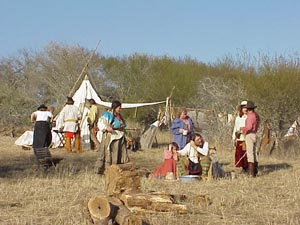 |
|
![]()
|
Home
Getting Started
Further Up The Trail
Resources
Groups
Western Fur Trade
Texas Rev
US Military
In Memoriam
|
Oil clothCatching up on a weeks worth of mail.... Some ramblings on my misadventures of waterproofing canvass and wood using mostly non-traditional methods.... I also have to second the Thompson's method. Don't need to dye it though. A weekend at Hearne gives it a nice earthy color. The one drawback I found to this method, is that there is a certain aroma to the ground cloth for a rather long period of time. You can get rid of it quickly by locking it in your truck over a very hot sunny weekend. Aroma goes right out of the cloth and into the seats. DAMHIKT. Pre shrunk canvas, and a half dozen coats of Thompsons will darn near make a cover for a bull boat. I remember one Ft. Parker rendezvous where I used this ground cloth with my diamond. Woke up in the morning below the current water level, and still dry. Don't let it catch fire though. I've used linseed oil on some gunstocks years ago, and have tried it on various turnings. It leaves a yellow cast to light woods and cloth, and mildews easily on furniture left outside for any length of time. Teak oil does the same, although what I have is probably linseed base and never came near a teak tree. All of these require oxygen to cure the oil, so hanging it out in the air like others suggested earlier is definitely the right way to go. Somewhere in my woodworking files I have a post that gives the name of an outfit that sells a pure, old-time boiled linseed oil. Don't remember the name of the company, but the Woodcraft stores and website have it. I can dig it out if anyone is interested. One oil I've read about but never tried (yet) is pure tung oil. Apparently only 1-2 sources for the pure stuff, most of the rest is based on linseed and/or soybean oils. Any of these oils would probably benefit from some sort of UV inhibitor for extended outdoor use. I tried a weird water proofing on my second tipi, obtained secondhand from Wooden Hawk. The Blue Star Tipi company sold a liquid latex concentrate. Mix a gallon or two up in a trash can full of water and stick the whole thing in, slosh it around, take it out, put it back in the other end first this time, then leave it for a while. Evidently it was a slow cure silicone or latex rubber that soaked into the canvas and impregnates the pores. Anything not taken up by the cloth gets kind of a cottage cheese texture after a few hours, and that's how you tell if the rubber is cured. They claim it only lasts a year or two, presumably with the lodge set up most of the year. Anyway, it was a big help in helping that poor old lodge shed water, as I recall. Here are some links to info on oilcloth - making it and the oil http://www.codesmiths.com/shed/workshop/techniques/oilcloth/ http://www.moscowfood.coop/archive/oilcloth.html
|
![]()



